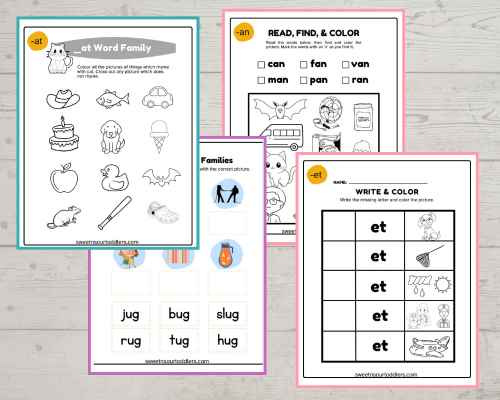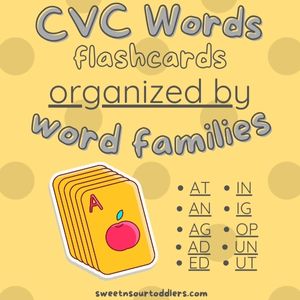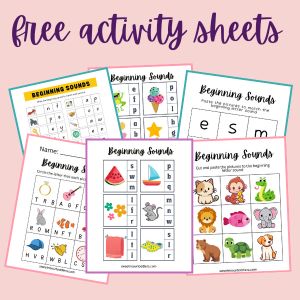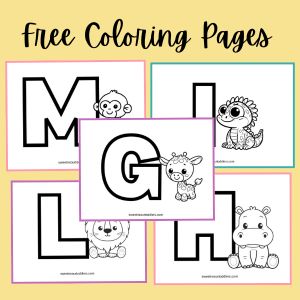Teaching word families is an essential strategy in early childhood literacy. Word families, also known as phonograms or rimes, are groups of words that share a common letter pattern and sound, such as “cat,” “bat,” and “rat.”
Understanding word families helps children decode new words and enhances their reading fluency.
In this blog post, we will explore the importance of word families and provide effective methods for teaching them.
At the end of this post you can get free download access to our super fun and engaging Word Family Worksheets.
Why Word Families Are Important
This page contains affiliate links. If you choose to purchase after clicking a link, I may receive a commission at no extra cost to you.
- Simplifies Phonics: Word families help simplify the process of learning phonics. By recognizing patterns in words, children can apply their knowledge to read and spell new words with similar patterns, reducing the cognitive load and making learning more efficient.
- Enhances Reading Fluency: When children are familiar with word families, they can quickly recognize and read new words that belong to those families. This ability to decode words rapidly improves their reading fluency and confidence.
- Builds Vocabulary: Teaching word families expands a child’s vocabulary. As they learn the base word, they also learn related words, enriching their language skills and comprehension.
- Supports Spelling Skills: Word families provide a framework for spelling. Children can use their understanding of word patterns to spell new words accurately, reinforcing their phonetic knowledge.
- Boosts Confidence: Mastering word families gives children a sense of achievement. This success encourages them to tackle more complex reading tasks with greater confidence and motivation.
How to Teach Word Families
Teaching word families can be an enjoyable and interactive experience. Here are some effective strategies:
1. Introduce One Family at a Time: Start with a single word family, such as “-at” (cat, bat, hat). Focus on this family until the child is comfortable with it before moving on to another word family. This step-by-step approach prevents overwhelming the child and ensures mastery.
2. Use Word Family Charts: Create a chart for each word family. Write the word family at the top (e.g., “-at”) and add words that belong to that family underneath (cat, bat, hat, mat). Display these charts in a visible place where children can refer to them regularly.
3. Engage in Word Sorting Activities: Provide a mix of words and ask children to sort them into their respective word families. This activity reinforces their understanding of patterns and helps them identify word families more easily.
4. Read Word Family Books: There are many children’s books designed to highlight specific word families. Reading these books together can reinforce the patterns and make learning enjoyable. Look for books that focus on one word family at a time to avoid confusion.
5. Word Family Worksheets: Utilize worksheets that focus on word families. These worksheets often include activities like matching words to pictures, filling in missing letters, and writing words from a specific word family. Worksheets provide structured practice and reinforce learning through repetition.
Get your interactive, fun and engaging word family worksheets sent straight to your inbox by signing up below!
6. Incorporate Rhyming Games: Play rhyming games that emphasize word families. For instance, say a word and ask the child to come up with words that rhyme with it, focusing on a specific word family. This activity makes learning fun and helps children recognize patterns in sounds.
7. Create Word Family Trees: Draw a tree and write the word family root (e.g., “-an”) at the base. Then, add branches with different words from the family (can, fan, man). This visual representation helps children understand the concept of word families.
Conclusion
Teaching word families is a powerful tool in developing a child’s reading and spelling abilities. By recognizing patterns in words, children can decode new words more easily, enhancing their reading fluency and confidence.
Using a variety of interactive and engaging methods, parents and educators can make learning word families a fun and effective process. As children master word families, they will be better equipped to tackle more complex reading tasks, paving the way for lifelong literacy success.
Looking for phonics worksheets that help your child practice their reading skills in a fun and engaging way? I’ve put together some amazing activity sheets that will get your kids hooked onto reading!

These reading activity sheets cover the fundamentals of reading like beginning sounds, CVC words, phonemic awareness and word families. They are simple enough for a 2-3 year old to do easily.
They also incorporate super fun elements like matching, cutting and pasting, coloring and tracing.
Sign up below and I’ll send these straight to your inbox!
Interested in teaching your child to read fluently and have no clue where to begin?
If you’re like me, you want to start teaching your kids to read fluently but you have absolutely no idea how to begin. I stumbled across Children Learning Reading completely by accident and I was so glad I did.
I used the Children Learning Reading program and by spending 10 minutes a day, I saw some phenomenal results! By the age of 3, my daughter was fluently reading 3 to 4 word sentences and short stories.
She’s 5 now, reads at 3rd grade level and I literally need to ask her to come out of her reading corner!
Children Learning Reading is a phonics based method of teaching little ones to read, perfectly crafted for the 2-6 year old age group. It’s what I used for my 2.5 year old and I saw some incredibly impressive results.
And I’m not alone. You can see the raving reviews from thousands of other parents who couldn’t believe how quickly their kids learned to read fluently!
- No previous teaching skills required by parents
- No prep work required, all the work has been done for you
- 10 minutes/day spanning 12 weeks to see some epic results
Here’s my detailed review on Children Learning Reading and how I was able to see immediate results within a few weeks.
We think you’ll enjoy reading these posts next:
7 Creative Ways to Teach a Toddler to Love Reading
5 Toddler Pre-Reading Skills and How to Inculcate Them
10 Inspiring Ideas For Setting Up An Insanely Cute Toddler Reading Corner
Children Learning Reading Review – An Honest Opinion From a Mom
Understanding and Teaching CVC Words: A Guide for Educators and Parents





Leave a Reply